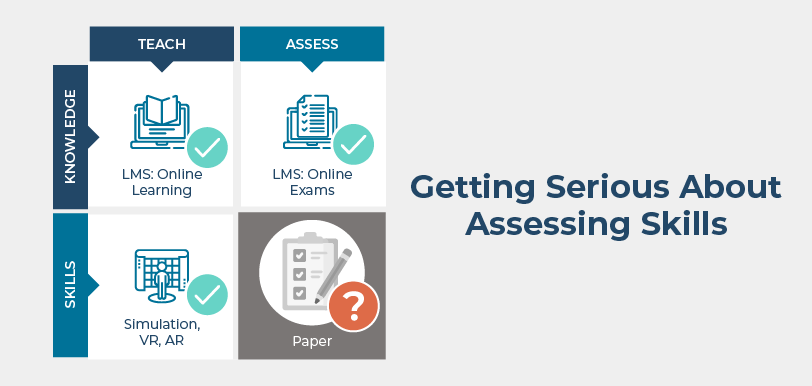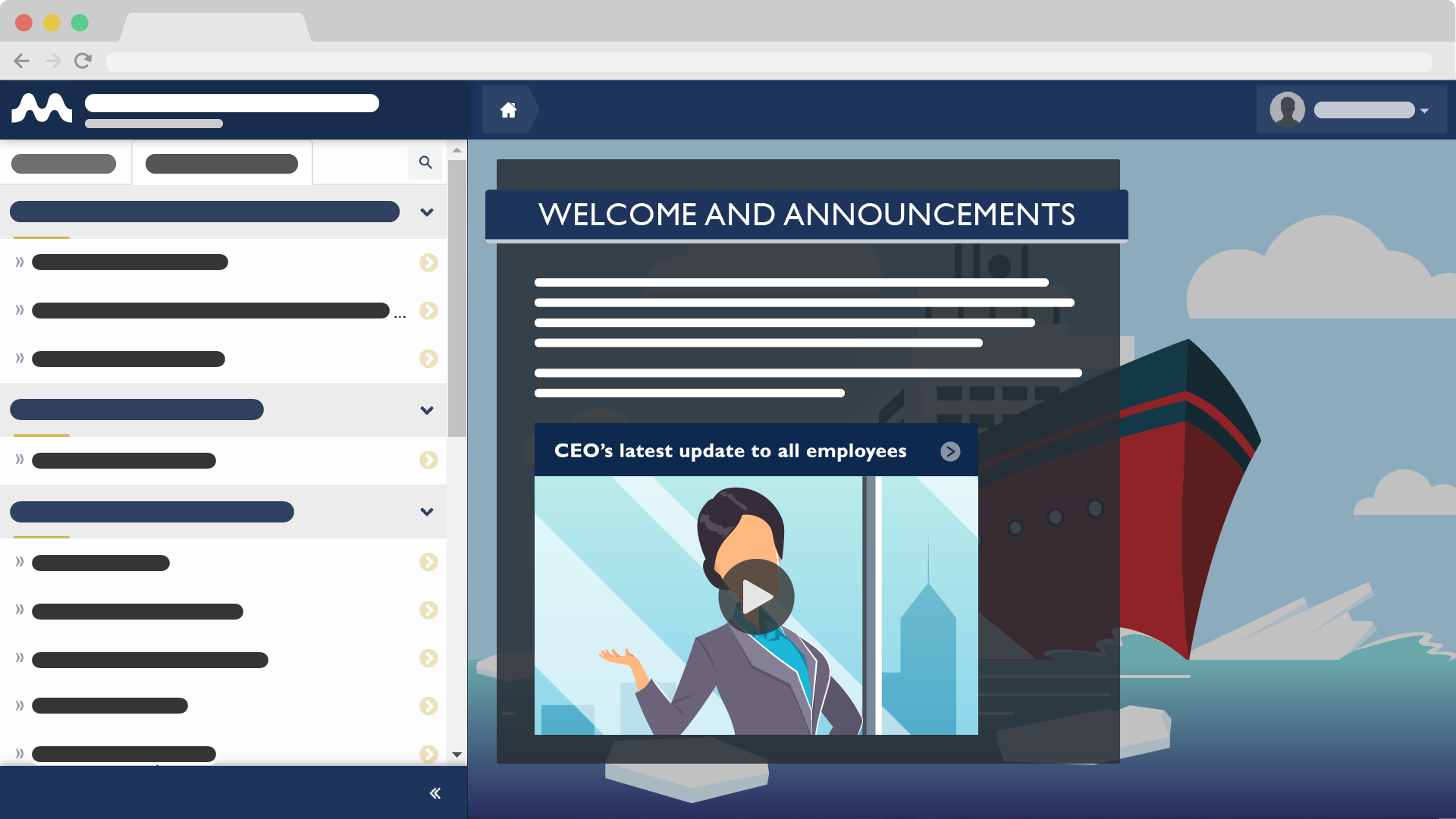What is the Most Effective Media for Maritime Training?
Feb 2, 2017 Murray Goldberg 3 eLearning, Maritime TrainingIntroduction
Training is moving online – or more correctly, to a blended model. This is more than a trend. It is a move to more effective, accessible, and efficient education. As someone involved in maritime training, it is important to think about and understand what makes the difference between “good” and “not good” eLearning implementations. As with all other training methods, not all eLearning experiences are created equally.
In the 18 years that I have been involved in eLearning as a researcher, instructor and LMS developer, I have been fortunate to have had a front row seat to all manner of eLearning implementations; some good, and some not so good. One of the many attributes that makes an eLearning implementation effective and efficient is appropriate use of media.
By media, I am referring to the choice of text, imagery, video, simulations and even gaming – or any combination of those – as ways of delivering eLearning. I have also been fortunate to have had a front row seat to a lot of discussions and opinions regarding the use of media. What I have found surprising is that I frequently run into people who believe that there is a strict ordering of media. Text is worst. Images are better. Video is better still, and so on.
This is a misguided opinion because each media type has its strengths and limitations. The best implementation is the one that chooses media appropriately to achieve the desired goals.
In this short series of articles, I am going to look at some of the most popular media types and discuss their relative strengths and weaknesses. This first article will introduce the subject and focus on text as an educational medium. Some of what I say may surprise you.
The next article (two weeks from now) will comment on images, audio, video, simulations and the use of gaming technologies for maritime training. Please click here if you would like to be alerted when I publish that and future articles. Let’s get started.
Choices!
There is no shortage of choice when it comes to eLearning media types. We are all familiar with the use of text, audio, images and video in eLearning. There are other more esoteric media types such as web-based simulations, gaming and immersive environments.
And just as there is no shortage of media types to choose from, there is no shortage of opinions on what constitutes the best choice. It is common to run into the opinion that the more sophisticated media types are automatically better at delivering a quality learning experience.
I disagree.
Each media type has advantages and limitations. The best choice requires careful consideration of your learning goals, the knowledge and skills you are training, the nature of your audience, your budget, and how frequently the training content changes.
And although we will look at individual media types, it has been found that combining media types provides the best results. This takes advantage of the strengths of each while minimizing the limitations of any one. It also serves to provide learning reinforcement which is well aligned to how we learn. This is a very powerful finding which has been proven in both research and experience and I’ll talk more about it in the next blog post.
No Significant Difference
One important fact to note is that most research suggests that, broadly speaking, when training content is held constant, changes in delivery media create no significant difference in student outcomes or satisfaction. Regardless of whether a course is taught in person, on the web or using video, the outcomes are the same. This is called the “No Significant Difference” (NSD) phenomenon and it is the subject of a book analyzing 355 research reports on the subject : Thomas L. Russell, “The No Significant Difference Phenomenon: A Comparative Research Annotated Bibliography on Technology for Distance Education”.
If there is no difference, then you might conclude that the best choice is to simply select the cheapest delivery mode. Sometimes this is indeed the correct thing to do, but at other times it is not.
First, it is important to remember that NSD research looks broadly at a variety of knowledge courses taught at universities. The maritime industry, however, is different than higher education in that there is a strong focus on skills. The best media choices for knowledge learning are not necessarily the best ones for skills development.
Secondly, although the population, on average, learns knowledge equally well from any media type, individuals often report being able to learn better from one media type. As such, the nature of your audience will influence your media choice.
Text – Yes it IS Effective!
People love to hate eLearning implementations filled with text. They are often viewed as slow, sleep-inducing, and ineffective. I have a very different view. Almost every complaint leveled against text as a learning media is, in fact, a criticism not of text as a media type, but of the quality of the writing.
Text, written well, can be incredibly compelling. It can be fascinating! It can very effectively and very comprehensively convey knowledge. Every one of us has read outstanding examples of writing. Textbooks, love them or not, have been a staple of education since the invention of the printing press. Part of the reason for their longevity is the simple fact that they are effective.
So text can be an excellent instructional media – but as with any media, it must be done well to be effective. Likewise, any other media type, executed poorly, can be very boring and completely ineffective. Therefore, I consider the choice of media type, in most cases, much less important than the quality (writing in this case) and implementation. A great implementation will be effective regardless of media type. A poor one will not.
Density
Text has a number of advantages. One is that it is a very “dense” medium. That is, it can convey a lot of detailed information with a very small footprint. This is a two-edged sword. The benefit is the ability to convey a lot of detail. The downside is that it is common to mistakenly pack too much material without providing enough structure, time and supporting instruction to help consolidate the knowledge.
This speaks to the power of blended learning. For example: use text to document and convey knowledge, and hands-on practice to relate that knowledge to the skills it supports.
If you have a lot of detailed information to convey, text may be a very good choice.
Self-Directed
Text also has the wonderful property of being easily searched and scanned. We take this for granted, but it is actually very powerful. Our brains are adept at quickly scanning over text to find what we are looking for and skipping sections that we do not find to be relevant. An LMS may further provide the ability to search for keywords in the text. This allows us to be more self-directed in our learning compared to media such as videos which are generally neither searchable nor easily scannable.
If you want your trainee to easily be able to focus on the sections relevant to them, text may be your friend.
Initial Cost and Ongoing Maintenance
Text comes with another enormous advantage: low cost. Cost is a great advantage in itself because low cost means that you can do much more with a fixed budget than you can with any other media choice.
However, the benefit is actually much deeper. Text is not only comparably inexpensive to initially create, but it is inexpensive to update. This is in stark contrast to the cost of updating other media types such as videos and simulations. Small changes to those are very, very expensive in comparison.
We especially care about cost for any subject of instruction which is likely to need frequent updating. If you choose a media type which is more expensive to update, your learning resources will be less likely to receive updates. It will progressively become less effective and less relevant.
Text, on the other hand, is very quick and easy to update and correct. It can be updated quickly to respond to subject matter changes and user feedback. This means that text will often be more relevant, correct and up-to-date than its counterparts.
This is very important – when you use other media types, you are not only committing to an increased initial cost, but are also committing to increased maintenance costs for the lifetime of that resource.
Our experience at BC Ferries has been that learning materials are in constant flux due to factors such as continuous improvement, ship refits, the availability of new information and so on. To support updates we have created a simple mechanism which allows all trainees and trainers to provide feedback when they see a needed change. The result is quick and efficient maintenance of the learning resource, leading to a high degree to confidence and buy-in.
Another important consideration is that even if the instructional subject is unlikely to change in the near term, your execution of it is unlikely to be perfect out of the gate. Once in use, you are likely to think of additional information to add and to receive suggestions for improvement. The ability to update the materials at low cost will facilitate continuous improvement. High-cost materials impede this process.
Limitations
Skills vs. Knowledge
Text as a media type does have some limitations. One downside of text is that it is not very useful for teaching skills. In order to be proficient at a skill, hands-on experience is critical.
Having said that, every skill requires a foundation of knowledge. Therefore, teaching skills is often best achieved using a blended approach. First teach the knowledge which underlies the skill (text can be used for this) and then move to a hands-on training phase where demonstration and practice take place.
Simulation can also be an excellent skill acquisition and reinforcement tool. So while text alone cannot be used to teach a skill, a combination of text (or other media) and hands-on practice is often the most effective approach.
Language Barriers
Another issue with using text alone is that trainees with a different first language will have more difficulty. This is the greatest limitation of text in an our industry where participants are from all parts of the globe. English descriptions may be effective for those whose first language is English, but may be less than effective for those with other language backgrounds.
There are ways to reduce the impact of the issue.
First, where possible, translations are effective. In cases where there are only two or three languages which need to be covered, this can be a viable strategy. In this case the expense of creation and maintenance is increased, but the costs are likely still much lower than for other media types.
If translation is not viable or the audience is too diverse, then supplementing the text with an audio transcription can help reduce the issue. First, some trainees may have experience working in an English-language setting, but have little formal English-language training. Those people are likely to have greater comprehension of spoken English. Second, by providing two “deliveries” of the same content (spoken and written), you will accommodate a greater breadth of individual learning styles and language competencies. So while it will always be difficult to learn a subject using a non-native language, there are some approaches which can help.
Conclusion
Using text (vs. images, videos, etc) as an instructional medium can be highly effective and very cost efficient as long as it is done well and matched to the learning goals and audience composition. It allows for deep coverage of the subject and is efficient to create and maintain. Having said that, like all instructional media, text does have limitations. It is often best used in combination with other media types. We will discuss the strengths and limitations of these other media types, as well as combining media types, in the next article.
Until then, take care and feel free to click here if you would like to be alerted when I publish that and future articles.
Follow this Blog!
Receive email notifications whenever a new maritime training article is posted. Enter your email address below:
Interested in Marine Learning Systems?
Contact us here to learn how you can upgrade your training delivery and management process to achieve superior safety and crew performance.







Great article! Many thanks. May God bless you, your family and your companies all the time.
Capt! So good to hear from you and thank you for the very generous comment. All the best for a happy and healthy 2017.
Great article! Many thanks. May God bless you, your family and your companies all the time.